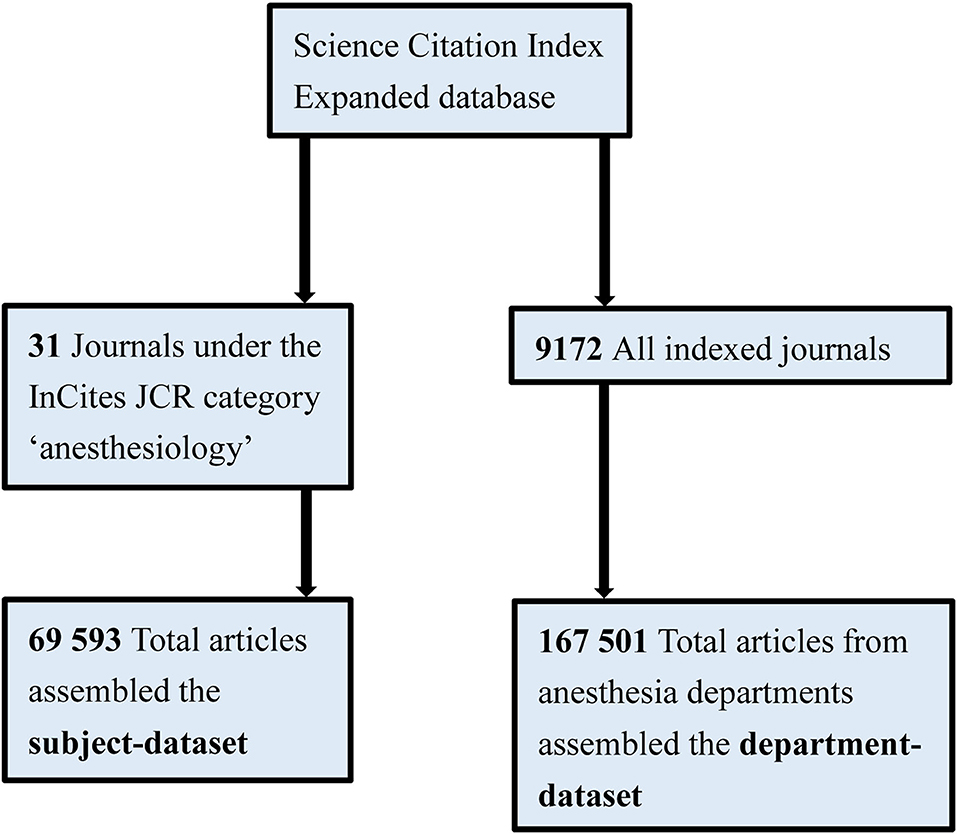- 1Division of Urology, Department of Surgery, Chang Gung Memorial Hospital-Linkou Branch, Taoyuan, Taiwan
- 2National Central Library, Taipei, Taiwan
- 3Department of Library and Information Science, National Taiwan University, Taipei, Taiwan
- 4Department of Anesthesiology, Taipei Veterans General Hospital and National Yang Ming Chiao Tung University, Taipei, Taiwan
Background: Publication activity in the field of anesthesiology informs decisions that enhance academic advancement. Most previous bibliometric studies on anesthesiology examined data limited to journals focused on anesthesiology rather than data answerable to authors in anesthesia departments. This study comprehensively explored publication trends in the field of anesthesiology and their impact. We hypothesized that anesthesiology's bibliometric scene would differ based on whether articles in the same study period were published in anesthesiology-focused journals or were produced by authors in anesthesia departments but published in non-specialty journals.
Methods: This cross-sectional study used bibliometric data from the Science Citation Index Expanded database between 1999 and 2018. Two datasets were assembled. The first dataset was a subject-dataset (articles published in 31 journals in the anesthesiology category of InCites Journal Citation Reports in 2018); the second dataset was the department-dataset (articles published in the Science Citation Index Expanded by authors in anesthesia departments). We captured the bibliographical record of each article in both datasets and noted each article's Institute for Scientific Information code, publication year, title, abstract, author addresses, subject category, and references for further study.
Results: A total of 69,593 articles were published—cited 1,497,932 times—in the subject-dataset; a total of 167,501 articles were published—cited 3,731,540 times—in the department-dataset. The results demonstrate differences between the two datasets. First, the number of articles was stagnant, with little growth (average annual growth rate = 0.31%) in the subject-dataset; whereas there was stable growth (average annual growth rate = 4.50%) in articles in the department-dataset. Second, only 30.4% of anesthesia department articles were published in anesthesiology journals. Third, journals related to “pain” had the lowest department-subject ratio, which was attributable to a large portion of non-anesthesia department researchers' participation in related research.
Conclusions: This study showed that articles published in anesthesiology-focused and non-specialty journals demonstrate fundamentally different trends. Thus, it not only helps researchers develop a more comprehensive understanding of the current publication status and trends in anesthesiology, but also provides a basis for national academic organizations to frame relevant anesthesiology development policies and rationalize resource allocation.
Introduction
Academic publications are not only the transmission of scientific knowledge but also the presentation of research achievements. Bibliometrics includes the application of mathematical and statistical methods to academic publications, and allows researchers to decipher the current research activities within a specific academic discipline (1–3). With the recent developments in anesthesia practices and the increasing endeavors of scientific research, anesthesia studies and their clinical applications have made great strides, which invites further research on anesthesiology-related bibliometric studies. In recent years, there have been a number of bibliometric studies on anesthesiology, focused on the investigation of research publication and impact in different countries (4–7), specific institutes (7–9), and individual authors (10, 11).
Notably, most bibliometric studies on anesthesiology examined data are only limited to anesthesiology journals, not all those produced by authors in anesthesia departments. Previous studies limited to anesthesiology journals reported the decreasing global publication of work on anesthesiology (6), including in the United States (12, 13), European countries (14), and the United Kingdom (15). However, this is difficult to quantify (16, 17), because many influential and highly cited anesthesiology-related papers are published in non-anesthesiology journals. Thus, the data scope of bibliometric studies on anesthesiology should be expanded from the subject-field journals to the authors' affiliated departments.
Research activity of anesthesiology includes both clinical and basic studies. Distinct from the aforementioned studies on anesthesiology conducted on a subject-field basis, there were a few bibliometric studies on global clinical trials (18), as well as publication of clinical research from the G-20 countries (19), the European countries (20, 21), Scandinavian countries (22), Canada (23), and East Asia (24), based on authors' affiliated departments. It is important to also inspect comprehensive department-based data, including all clinical and basic studies, in order to more thoroughly understand the overall condition of publications dealing with anesthesiology.
To date, there have been no formal bibliometric studies on global publication that include clinical and basic studies, nor focusing on the impact of anesthesiology in both the subject-field dataset and the researchers' affiliated department dataset. Hence, we hypothesized that the bibliometric scene is different between the subject-field dataset and department dataset in the same study period. We decided to conduct this study to observe global trends in publication and the impact of both the subject-field dataset and department dataset on anesthesiology in the period 1999–2018.
Materials and Methods
Study Design
This study was conducted in line with the ethical principles for medical research according to the Declaration of Helsinki. No ethics committee approval was required for this bibliographic study, because the data were obtained from the public domain of the National Taiwan University Library website on September 30, 2019. Data analyses were conducted from October 1, 2019, through December 31, 2019. We observed the Strengthening the Reporting of Observational Studies in Epidemiology (STROBE) reporting guidelines for cross-sectional studies.
Bibliometric Approach
Our study conducted a bibliometric analysis and collected anesthesiology bibliographic data across 20 years, from 1999 to 2018 (Figure 1). To achieve its research purpose, this study established two anesthesiology datasets: the subject-field dataset [papers from journals indexed in the subject-field according to the InCites Journal Citation Reports (JCR) category], and the department dataset [papers published in the names of departments from the Web of Science: Science Citation Index Expanded (SCIE) database]. For the former, we collected papers from 31 journals under the JCR category “anesthesiology” in 2018. We searched the journal names on the SCIE database and obtained the papers. For the latter, we defined anesthesia departments as academic groups or organizations that perform anesthesiology-related practices; therefore, these department papers referred to those published by clinicians and related researchers. In order to maximize the complete download of the global anesthesia department output, we use keywords in seven languages (English, Dutch, French, German, Italian, Portuguese, and Spanish) to conduct our search using authors' affiliation-addresses present in the SCIE database, and the represented departments which published papers were analyzed. Based on the research on the history of anesthesiology, the classical use of anaesthesiology (US: anesthesiology) or anaesthesia (US: anesthesia) to describe the specialty of anesthesiologists (25, 26); so we used anesthes*, anaesthes*, anesthés*, anästhes*, and anestes* as the keywords for search. The symbol “*” is a placeholder for retrieving all search items that start with the preceding text. This may maximize the access to papers published by authors in the anesthesia department.
Only the document type “article” was analyzed in this study. “Article” was understood as a report of original research (27), and included research papers, brief communications, case reports, and technical notes. We noted the bibliographical data of each article in both datasets and recorded each article's Institute for Scientific Information code, publication year, title, abstract, author addresses, subject category, and references for advanced study.
As with our previous bibliometric studies (7, 28), the whole counting method (29), in which each co-author and publication were counted once, were used in this study. For the counting of research field, there were a total of 236 subject fields in the 2018 JCR, and each article in the SCIE database would be assigned to at least one subject field. In order to identify the proportion of anesthesiology publications among the different subject fields, this study adopted a specific classification and counting method, that is, anesthesiology = 1; other fields (non-anesthesiology) = 0. For example, when Paper X was assigned to “anesthesiology” and “Field A,” then this article would be coded as 1, and “Field A” would not be coded. By comparison, when Paper Y was assigned to “Field B” and “Field C,” then this article would be coded as 0.
Statistical Analysis
Through calculating the number of articles and their times of citation, this study analyzed the publication trend and impact of both the subject-field and department datasets. To further evaluate the differences in terms of research publication between the two datasets, we calculated a “department-field ratio” using the following formula:
*JD = the number of articles of a journal's department; WD = the number of articles of the departments worldwide; JF = the number of articles of a journal's subject-field; WF = the number of articles of the subject-field worldwide.
The department-field ratio can help us understand the difference between the department dataset and the subject-field dataset in terms of their number of articles within the same journal. A higher department-field ratio implies a smaller difference between the two datasets, whereas a smaller ratio indicates a greater difference.
Because our objective was only to describe the data of the two datasets, descriptive statistics were used.
Results
Overall Number of Articles
According to the subject-field dataset, there were 69,593 articles published from 1999 to 2018, with an average of 3,480 articles per year. Since the total number of articles published in the first 10 years made up 48.7% of the overall amount, it can be concluded that the remaining 10 years of the period exhibited a weak growth (2.56%). The number of articles per year from 1999 to 2008 grew from 3,346 to 3,625, achieving an average annual growth rate of 0.91%; meanwhile, publications from 2009 to 2018 dropped from 3,618 to 3,504, resulting in a negative average annual growth rate of −0.25%.
In the department dataset, there were 167,501 articles published from 1998 to 2018, with an average of 8,375 articles per year. Within that period, there was steady growth; the first 10 years (1999–2008) demonstrated a stable rise, and the remaining 10 years (2009–2018) showed a robust growth, which was corroborated when the annual number of articles exceeded 10,000 by 2014. Moreover, the 3 year-long periods with the highest annual growth rates were all included in the second half of the 20 years, which were 2010–2011 (8.88%), 2015–2016 (8.82%), and 2012–2013 (8.23%).
The differences in annual number of articles between the subject-field dataset and the department dataset throughout the 20 years are reflected in Figure 2. It can be seen that the total number of articles published by authors within anesthesia departments was 2.4 times that of the subject-field. The average annual growth rate from 1999 to 2018 of the subject-field was around 0.31%, whereas that of the department was 4.50%.
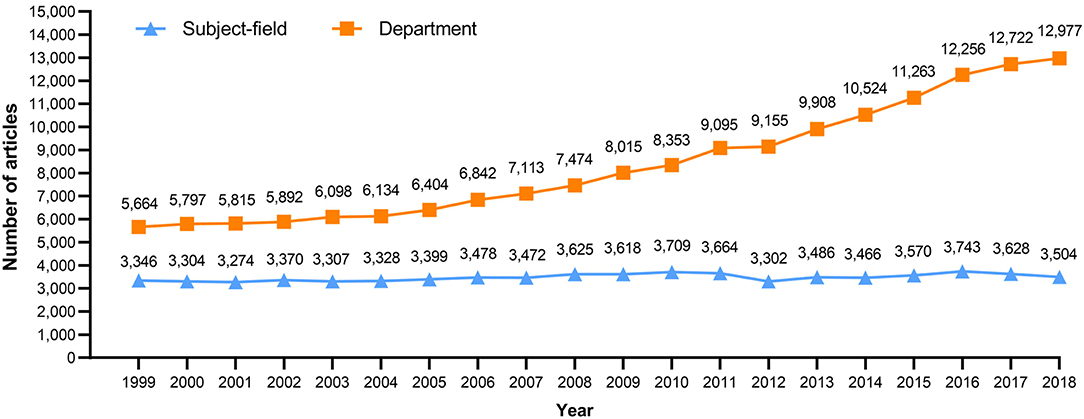
Figure 2. Trend of articles published in the subject-field dataset and the department dataset from 1999 to 2018.
Analysis and Comparison of the Two Datasets
By comparing the subject-field dataset with the department dataset, Figure 3A presents the affiliations of authors in anesthesiology. It shows that anesthesia department researchers were the main contributors to publications; 73.2% of the subject-field articles were produced by them and 26.8% of articles were produced by authors who belonged to the other domains.
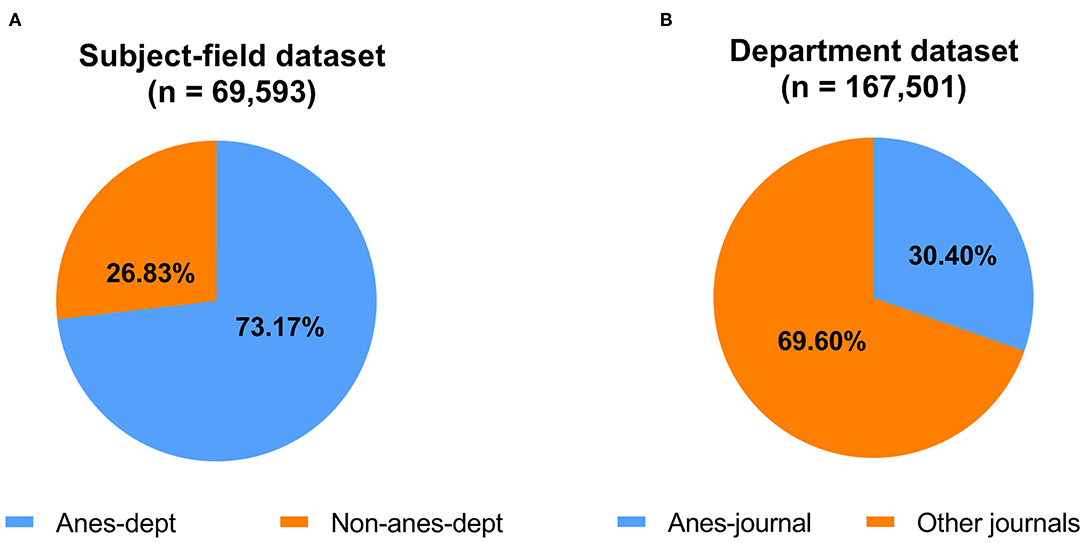
Figure 3. Percentage distribution of articles. (A) Authors of articles in the subject-field dataset from anesthesia departments (anes-dept) and non-anesthesia departments (non-anes-dept) from 1999 to 2018. The size of the circles represents the total number (n) of published articles. (B) Fields of publication in the department dataset from 1999 to 2018. The size of the circles represents the total number (n) of published articles from anesthesiology journals (anes-journals) and other journals.
The department dataset manifested the proportion of anesthesia department researchers who published articles in anesthesiology. Figure 3B shows that only 30.4% of anesthesia department articles were published by journals under the anesthesiology category in JCR 2018, while more of them (69.6%) were published by journals of other fields.
Research Publication
Table 1 lists the top 20 journals with the most articles from the subject-field dataset, with Anesthesia and Analgesia (12.9%), Anesthesiology (7.9%), and Pain (7.2%) as the top three journals. These three journals accounted for 28.0% of the total, substantiating that little more than a quarter of the articles were published by them.
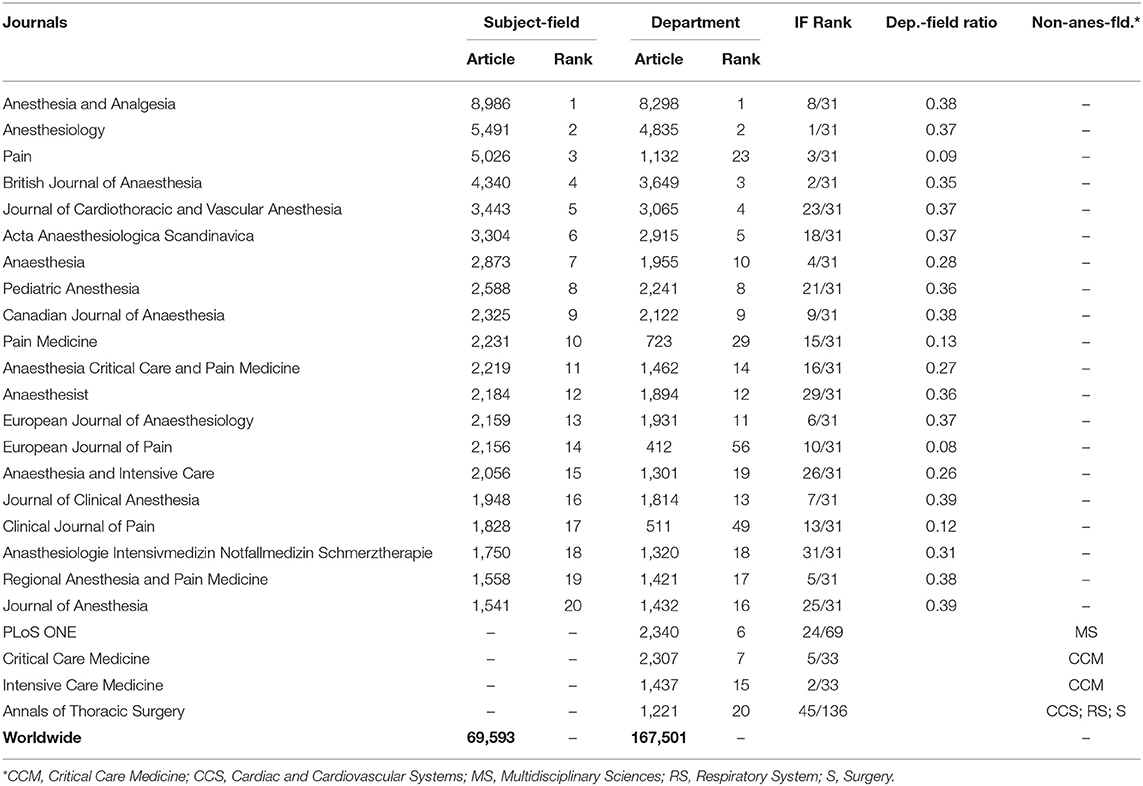
Table 1. The top 20 journals by number of articles from the subject-field dataset and department dataset in 1999–2018.
In the case of the department dataset, Anesthesia and Analgesia included the highest number of articles (4.9%), with the two next highest being Anesthesiology (2.9%) and the British Journal of Anesthesia Anaesthesia (2.3%). The articles of the anesthesia department were more dispersed, with 167,501 articles published in 4,813 journals, and they were more involved with cross-field and non-anesthesiology field journals, such as PLoS ONE (the field of multidisciplinary sciences), Critical Care Medicine (the field of critical care medicine), Intensive Care Medicine (the field of critical care medicine), and Annals of Thoracic Surgery (the fields of cardiac, cardiovascular, and respiratory systems, and surgery).
Research Impact
Table 2 enumerates the journals that accumulated the most citation counts in the subject-field dataset from 1999 to 2018. In this dataset, the top four journals with the most citations also occupied the top four places by number of article published, though in a different order; this means, as far as the indicators of “research publication” and “research impact,” that they were the leading journals in the field, with an outstanding number of articles and influence.
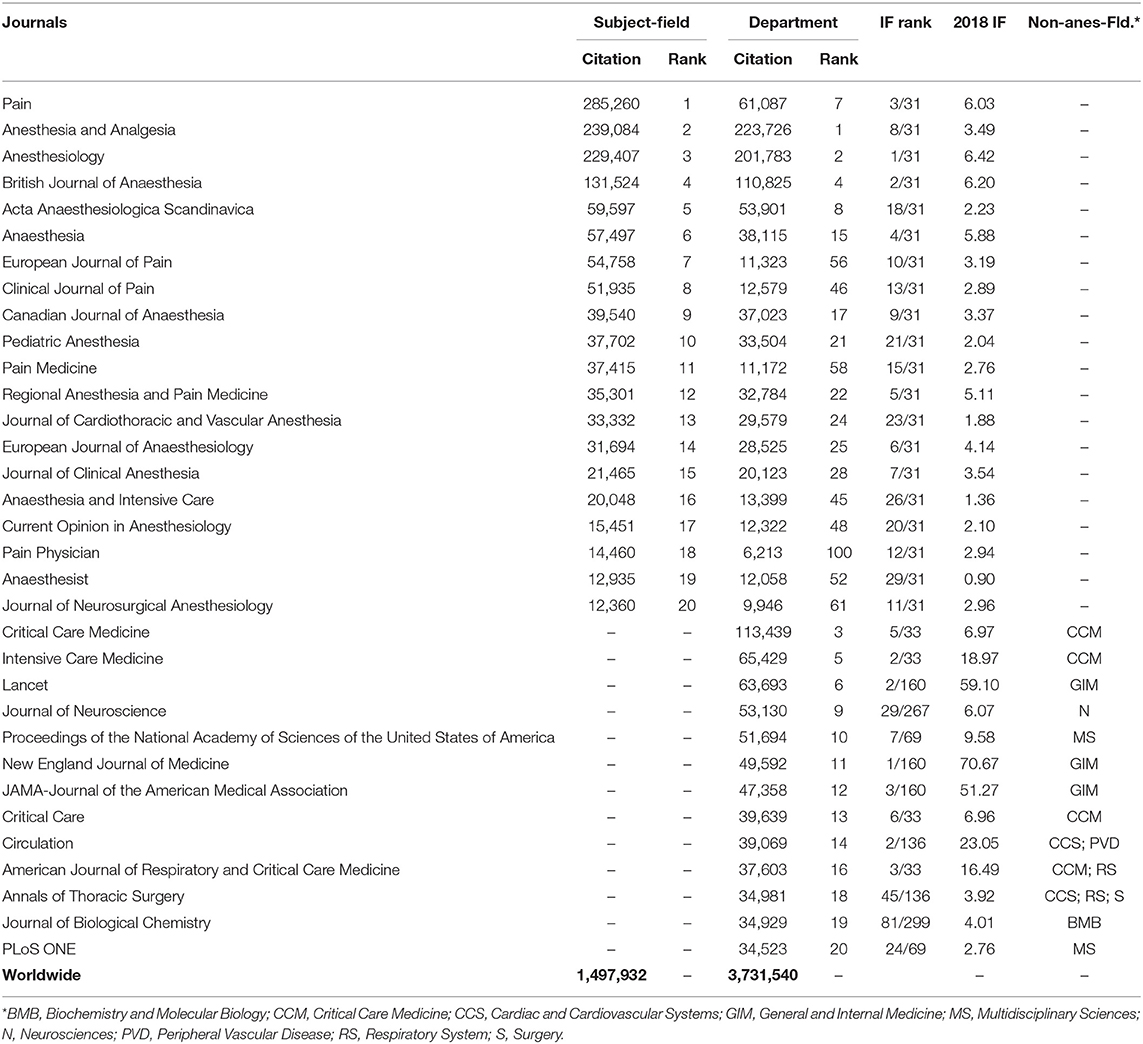
Table 2. The top 20 journals by number of citations in the subject-field dataset and department dataset in 1999–2018.
According to Table 2, there were 13 journals in the department dataset of top 20 journals citations that belonged to a non-anesthesiology subject, and these can be either divided or overlapped onto nine other medical subjects. The above phenomenon indicates a wide range of diversity that anesthesia department articles exhibited. It is noteworthy that some articles produced by the anesthesia department were published in prestigious journals in the general and internal medicine subjects, such as New England Journal of Medicine (IF = 70.67), Lancet (IF = 59.10), and JAMA (IF = 51.27), conveying that those articles, too, held a considerably high academic influence.
Discussion
To our best knowledge, this is the first bibliometric anesthesiology study that synchronously analyzed articles in the subject-field dataset and the department dataset, covering data that spanned a long period of two decades. The results demonstrated some differences between these two datasets, presented in terms of the real academic publication activity in anesthesiology.
First, the present study illustrates a steady trend in the number of articles in the subject-field dataset and a stable growth in publication is observed in the department dataset across our observation period (1998–2018) (Figure 2). In some previous bibliometric studies, data from anesthesiology journals focused on clinical studies and reported a steady trend in publications before 2004 (6, 13–15) and a decrease in publications after 2004 (6, 14, 15). This phenomenon of a decrease in publications was not seen in the subject-field dataset of our study, which is consistent with our previous finding (7). This discrepancy may be a result of the inclusion in our study datasets of both clinical and non-clinical studies. Moreover, we showed that the number of publications from global anesthesia departments had a steady trend before 2004, but had an average annual growth rate that increased from 2.02 to 5.53% after 2004 (Figure 2). These findings were similar to former bibliometric studies of clinical research from anesthesia departments of G-20 countries (19), European countries (20, 21), and Scandinavian countries (22). Together with the subject-field's trend, the widening gap of publications between the two datasets was unveiled. Thus, the steady trend in publication in the subject-field dataset might not accurately reflect the actual activity of academic publication. In fact, there was increasing research done by anesthesiologists and related researchers, a phenomenon which likely explains the discrepancy between the two datasets from 2009 to 2018.
Second, our results show that a majority of articles (73.27%) from the subject-field dataset were produced by anesthesia department researchers (Figure 3A). In contrast, articles from the department dataset produced by anesthesia department researchers accounted for only 30.4% articles published in the 31 journals in the subject-field dataset (Figure 3B). Interestingly, a previous bibliometric study similarly reported that only 18% of laboratory research articles using molecular biology techniques from anesthesia department were published in anesthesiology journals (30); 82% of the articles were published in other biomedical journals. We also found that many of the articles by anesthesia department researchers that had a high number of citations were mostly published in non-anesthesiology-field journals (Table 2). This may explain why previous studies found that the decreasing number of articles in anesthesiology-field journals (6, 12–15) might be due to the changing submission direction of some authors. Together, these findings imply that authors sent their articles to other high-impact medical journals instead of those in the anesthesiology subject-field.
Our data also support the possibility that the articles published by the anesthesia department researchers revealed a myriad of subjects (Tables 1, 2), including: biochemistry and molecular biology, critical care medicine, cardiac and cardiovascular systems, general and internal medicine, multidisciplinary sciences, neurosciences, peripheral vascular disease, respiratory system, and surgery. Among them, critical care medicine received the most publication, whereas general and internal medicine generated a remarkable number of high-impact articles. In fact, anesthesia department researchers tended to obtain a higher degree of clinical cross-discipline involvement (31). We believe that cross-discipline interaction is important to provide the best care and break the boundaries between disciplines, through research, to provide our patients with better clinical outcome.
Notably, among the top 20 journals in the subject-field dataset (Table 1), there were four journals with a department-field ratio lower than 0.2, indicating a low publication rate from anesthesia department researchers. All four journals were international journals focused on the topic “pain.” Of all the journals, Pain presented an obvious variation in its ranking; in the subject-field dataset, it accumulated 5,026 articles and ranked the third, but in the department dataset, there were only 1,132 articles written by anesthesia department researchers and it ranked the 23rd. From the department-field ratio of 0.09, we may suggest that despite the profuse number of articles from Pain included in the subject-field dataset, nearly three quarters of them were written by non-anesthesia department researchers. This phenomenon was also perceivable in the European Journal of Pain (0.08), the Clinical Journal of Pain (0.12), and Pain Medicine (0.13). This was attributable to non-anesthesia department researchers' participation in research concerning “pain,” a topic whose representative journals were mostly composed of articles about basic medical science (32).
Bibliometric studies based on data from only either the subject-field or the researchers' affiliations could not fully represent the publication trends and impact in anesthesiology, and it is possible that such studies would produce biased findings (16, 17). As it compares the two synchronous datasets over the recent 20-year period, our study not only can help researchers gain a more comprehensive understanding of the current status of publication trends in anesthesiology, but also provide the exploitation of data and the use of novel information for national academic organizations to formulate relevant policies and rationalize resource allocation for the development of anesthesiology. This will encourage anesthesiologists to enhance the quality of their research for the benefit of patients.
This study's findings and implications have some potential limitations. First, we included only articles from the Web of Science: SCIE database, not all existing databases, such as PubMed. This indicates that some research papers are not included in this study. Although the SCIE database has a slightly smaller collection of articles in the medical field than PubMed, the SCIE database includes journals in a wider field (33), which helps to provide a more complete picture of the published fields of authors in the anesthesia department. In fact, we found that a few articles were published in humanities and arts journals, this finding in our study not likely to be found in PubMed. Briefly, we consider our results valid because the SCIE database is well-established and was the only database that provided the affiliations of all authors of a particular article for this long study period (33, 34). Next, some anesthesia departments and intensive care departments may have recently been merged and renamed, thus becoming a department with a broader name that does not include “anesthesia,” such as a department of perioperative medicine. Thus, this study may have omitted some publications because, for example, our keywords for anesthesia departments were not listed in the affiliation field for the department of perioperative medicine; therefore, articles from this department were excluded. However, it is likely that the small number of articles produced by these few departments are not significant compared to the 167,501 articles in the department dataset of our study. Finally, because of the limitations of the database, only publications in English were included, meaning that articles written in non-English languages may not all be identified. Nevertheless, we believe that English has been the dominant language in medical science for a long time (35).
In conclusion, our results not only explored the publication trends and impact in anesthesiology during the two recent decades, but also provided a more objective view of anesthesiology research activity. It can be seen that the publication trends in the subject-field dataset were stagnant, with little growth; whereas there was continuous growth in the department-dataset. For anesthesia departments, it was observed that more of the articles were published in cross-discipline journals or those of other subject-fields. Furthermore, a large portion of highly-cited articles were published in high-profile non-anesthesiology journals, and our results reveal the submission targets of anesthesia researchers.
Data Availability Statement
The datasets generated for this study can be found in online repositories. The names of the repository/repositories and accession number(s) can be found below: This cross-sectional study used bibliometric data from the Science Citation Index Expanded database between 1999 and 2018.
Author Contributions
S-YC drafted the first draft. M-HH and C-MH revised the manuscript for important intellectual content, provided administrative and obtained funding. L-FW and M-HH provided specific expertise on bibliometrics and contributed to data management. C-MH supervised this study. All authors were involved in study conception and design as well as data acquisition, analysis, interpretation, and reviewed and approved the manuscript.
Funding
This work was financially supported in part by the Ministry of Science and Technology (MOST), Taiwan, under Grant nos. MOST 106-2410-H-002-091-MY2, MOST 108-2314-B-075-025-MY2, MOST 110-2634-F-002-045, the Ministry of Education (MOE), Taiwan, under Grant nos. MOE 110L900204, MOE 110L9A002, and the Taipei Veterans General Hospital, Taiwan, under Grant no. V109C-167, V110C-146.
Conflict of Interest
The authors declare that the research was conducted in the absence of any commercial or financial relationships that could be construed as a potential conflict of interest.
Publisher's Note
All claims expressed in this article are solely those of the authors and do not necessarily represent those of their affiliated organizations, or those of the publisher, the editors and the reviewers. Any product that may be evaluated in this article, or claim that may be made by its manufacturer, is not guaranteed or endorsed by the publisher.
Acknowledgments
We are indebted to Ying-Han Chang, who extended a lot of assistance for data validation.
References
1. Thompson DF, Walker CK. A descriptive and historical review of bibliometrics with applications to medical sciences. Pharmacotherapy. (2015) 35:551–9. doi: 10.1002/phar.1586
2. Brandt JS, Hadaya O, Schuster M, Rosen T, Sauer MV, Ananth CV. A bibliometric analysis of top-cited journal articles in obstetrics and gynecology. JAMA Netw Open. (2019) 2:e1918007. doi: 10.1001/jamanetworkopen.2019.18007
3. Zdravkovic M, Berger-Estilita J, Zdravkovic B, Berger D. Scientific quality of COVID-19 and SARS CoV-2 publications in the highest impact medical journals during the early phase of the pandemic: a case control study. PLoS ONE. (2020) 15:e0241826. doi: 10.1371/journal.pone.0241826
4. Figueredo E, Sánchez Perales G, Muñoz Blanco F. International publishing in anaesthesia - how do different countries contribute? Acta Anaesthesiol Scand. (2003) 47:378–82. doi: 10.1034/j.1399-6576.2003.00105.x
5. Bould MD, Boet S, Riem N, Kasanda C, Sossou A, Bruppacher HR. National representation in the anaesthesia literature: a bibliometric analysis of highly cited anaesthesia journals. Anaesthesia. (2010) 65:799–804. doi: 10.1111/j.1365-2044.2010.06424.x
6. Li Z, Qiu LX, Wu FX, Yang LQ, Sun S, Yu WF. Scientific publications in international anaesthesiology journals: a 10-year survey. Anaesth Intensive Care. (2011) 39:268–73. doi: 10.1177/0310057X1103900218
7. Chen SY, Wei LF, Ho CM. Trend of academic publication activity in anesthesiology: A 2-decade bibliographic perspective. Asian J Anesthesiol. (2017) 55:3–8. doi: 10.1016/j.aat.2016.06.005
8. Moppett IK, Hardman JG. Bibliometrics of anaesthesia researchers in the UK. Br J Anaesth. (2011) 107:351–6. doi: 10.1093/bja/aer124
9. Ratnayake G, El-Boghdadly K, Pandit JJ. An analysis of the academic capacity of anaesthesia in the UK by publication trends and academic units. Anaesthesia. (2021) 76:500–13. doi: 10.1111/anae.15247
10. Pagel PS, Hudetz JA. Scholarly productivity and national institutes of health funding of foundation for anesthesia education and research grant recipients: insights from a bibliometric analysis. Anesthesiology. (2015) 123:683–91. doi: 10.1097/ALN.0000000000000737
11. El-Boghdadly K, Docherty AB, Klein AA. Analysis of the distribution and scholarly output from National Institute of Academic Anaesthesia (NIAA) research grants. Anaesthesia. (2018) 73:679–91. doi: 10.1111/anae.14277
12. Szokol JW, Murphy GS, Avram MJ, Nitsun M, Wynnychenko TM, Vender JS. Declining proportion of publications by American authors in major anesthesiology journals. Anesth Analg. (2003) 96:513–7. doi: 10.1097/00000539-200302000-00039
13. Pagel PS, Hudetz JA. Recent trends in publication of basic science and clinical research by United States investigators in anesthesia journals. BMC Anesthesiol. (2012) 12:5. doi: 10.1186/1471-2253-12-5
14. Walker E, Hankins MC, White SM. The effect of the European Clinical Trials Directive on published drug research in anaesthesia. Anaesthesia. (2009) 64:984–9. doi: 10.1111/j.1365-2044.2009.06011.x
15. Feneck RO, Natarajan N, Sebastian R, Naughton C. Decline in research publications from the United Kingdom in anaesthesia journals from 1997 to 2006. Anaesthesia. (2008) 63:270–5. doi: 10.1111/j.1365-2044.2008.05475.x
16. Pandit JJ. Anaesthetic research in the United Kingdom: publishing or perishing? Anaesthesia. (2008) 63:225–7. doi: 10.1111/j.1365-2044.2008.05473.x
17. Gibbs NM. Research activities among Australian and New Zealand anaesthetists. Anaesth Intensive Care. (2016) 44:9–10. doi: 10.1177/0310057X1604400102
18. Swaminathan M, Phillips-Bute BG, Grichnik KP A. bibliometric analysis of global clinical research by anesthesia departments. Anesth Analg. (2007) 105:1741–6. doi: 10.1213/01.ane.0000286149.57763.e7
19. Ausserer J, Miller C, Putzer G, Pehböck D, Hamm P, Wenzel V, et al. International publication trends originating from anaesthetic departments from 2001 to 2015. Anaesthesia. (2017) 72:1243–50. doi: 10.1111/anae.14016
20. Cools E, Ausserer J, Van de Velde M, Hamm P, Neururer S, Paal P. Anaesthesiology research in the European Union and the European Free Trade Association: an overview from 2001 to 2015. Eur J Anaesthesiol. (2017) 34:814–23. doi: 10.1097/EJA.0000000000000653
21. Cools E, Ausserer J, Van de Velde M, Hamm P, Paal P. Publications from university-affiliated anaesthesiology departments: a look at Belgium, France and the Netherlands from 2001 to 2015. Scientometric. (2019) 119:863–78. doi: 10.1007/s11192-019-03075-2
22. Miller C, Prenn R, Ausserer J, Hamm P, Neururer S, Paal P. Publications by Scandinavian university departments of anaesthesiology from 2001 to 2015. Acta Anaesthesiol Scand. (2018) 62:1304–13. doi: 10.1111/aas.13149
23. Tsui BC Li LX, Ma V, Wagner AM, Finucane BT. Declining randomized clinical trials from Canadian anesthesia departments? Can J Anaesth. (2006) 53:226–35. doi: 10.1007/BF03022207
24. Wang JO, Chen TJ, Kao S, Yeh TC, Chou LF, Ho ST. Scientific publications by anesthesia departments in East Asia. Scientometrics. (2012) 92:135–43. doi: 10.1007/s11192-012-0717-6
25. Haridas RP. Earliest english definitions of anaisthesia and anaesthesia. Anesthesiology. (2017) 127:747–53. doi: 10.1097/ALN.0000000000001764
26. Haridas RP. Origin of the word “anesthesiology”: Mathias J. Seifert, MD. Anaesth Intensive Care. (2018) 46:14–7. doi: 10.1177/0310057X180460S103
27. Donner P. Document type assignment accuracy in the journal citation index data of Web of Science. Scientometrics. (2017) 113:219–36. doi: 10.1007/s11192-017-2483-y
28. Chen SY, Wu JT. Global productivity of dermatological research: a bibliometric analysis from 1985 to 2014. Br J Dermatol. (2017) 176:234–6. doi: 10.1111/bjd.14802
29. Gauffriau M, Larsen PO, Maye I, Roulin-Perriard A, von Ins M. Comparisons of results of publication counting using different methods. Scientometrics. (2008) 77:147–76. doi: 10.1007/s11192-007-1934-2
30. Schreiber K, Girard T, Kindler CH. Bibliometric analysis of original molecular biology research in anaesthesia. Anaesthesia. (2004) 59:1002–7. doi: 10.1111/j.1365-2044.2004.03873.x
31. Klein AA, Earnshaw JJ. Perioperative care and collaboration between surgeons and anaesthetists - it's about time. Br J Surg. (2020) 107:e6–7. doi: 10.1002/bjs.11445
32. Mogil JS, Simmonds K, Simmonds MJ. Pain research from 1975 to 2007: a categorical and bibliometric meta-trend analysis of every research paper published in the journal, Pain. Pain. (2009) 142:48–58. doi: 10.1016/j.pain.2008.11.012
33. Falagas ME, Pitsouni EI, Malietzis GA, Pappas G. Comparison of PubMed, Scopus, Web of Science, and Google Scholar: strengths and weaknesses. FASEB J. (2008) 22:338–42. doi: 10.1096/fj.07-9492LSF
34. Kulkarni AV, Aziz B, Shams I, Busse JW. Comparisons of citations in Web of Science, Scopus, and Google Scholar for articles published in general medical journals. JAMA. (2009) 302:1092–6. doi: 10.1001/jama.2009.1307
Keywords: anesthesia, anesthesiology, bibliometrics, informetrics, research evaluation, scientometrics
Citation: Chen S-Y, Wei L-F, Huang M-H and Ho C-M (2021) Academic Publication of Anesthesiology From a Bibliographic Perspective From 1999 to 2018: Comparative Analysis Using Subject-Field Dataset and Department Dataset. Front. Med. 8:658833. doi: 10.3389/fmed.2021.658833
Received: 26 January 2021; Accepted: 03 September 2021;
Published: 29 September 2021.
Edited by:
Somchai Amornyotin, Mahidol University, ThailandReviewed by:
Hiroshi Morimatsu, Okayama University, JapanGianluca Villa, University of Florence, Italy
Copyright © 2021 Chen, Wei, Huang and Ho. This is an open-access article distributed under the terms of the Creative Commons Attribution License (CC BY). The use, distribution or reproduction in other forums is permitted, provided the original author(s) and the copyright owner(s) are credited and that the original publication in this journal is cited, in accordance with accepted academic practice. No use, distribution or reproduction is permitted which does not comply with these terms.
*Correspondence: Chiu-Ming Ho, Y21ob0B2Z2h0cGUuZ292LnR3; Y21obzY2QGdtYWlsLmNvbQ==
†These authors have contributed equally to this work and share first authorship
 Sy-Yuan Chen1†
Sy-Yuan Chen1† Chiu-Ming Ho
Chiu-Ming Ho